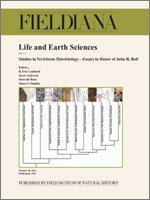We report the discovery of an early tetrapod skull from the St. Louis Limestone of Missouri, USA. It was found among a collection of coelacanths in the Museum für Naturkunde in Berlin, Germany, part of a larger collection donated to that institution by Jaekel containing other fish fossils from the same locality. The exact locality remains uncertain, but sedimentological analysis suggests that the specimens derive from the lower or middle part of the Upper St. Louis Limestone. The lithology is consistent with a deeper water marine setting, suggesting that the tetrapod specimen is an erratic. The skull is a natural mold exposed in palatal view, showing good detail of the bones preserved. Phylogenetic analysis shows it to be most closely related to colosteids, though retaining some plesiomorphic characters. Stratigraphic correlation shows that the St. Louis Limestone is older than the Verdi and Waugh Members of Iowa, here assigned to the Ste. Genevieve Formation, from which other colosteid specimens and Whatcheeria were found. The new specimen is thus both the earliest post-Devonian tetrapod from North America, and also the oldest colosteid-like tetrapod known.
How to translate text using browser tools
18 October 2012
A Colosteid-Like Early Tetrapod from the St. Louis Limestone (Early Carboniferous, Meramecian), St. Louis, Missouri, USA
Jennifer A. Clack,
Florian Witzmann,
Johannes Müller,
Daniel Snyder
ACCESS THE FULL ARTICLE
It is not available for individual sale.
This article is only available to subscribers.
It is not available for individual sale.
It is not available for individual sale.





